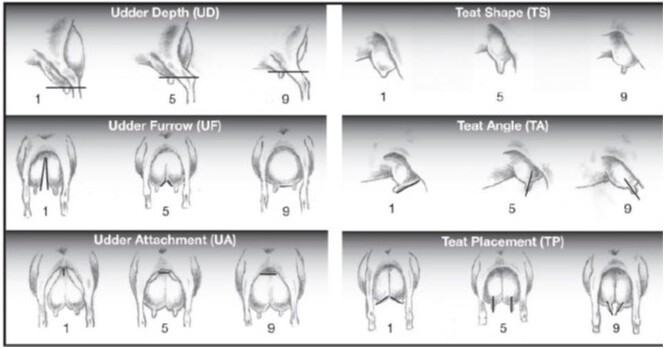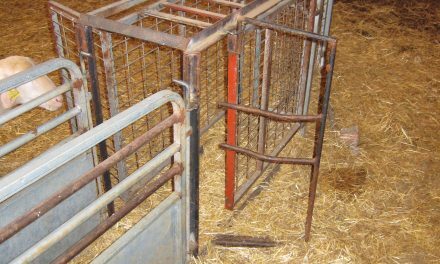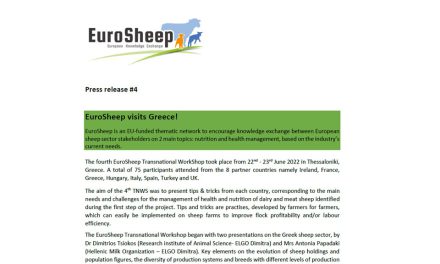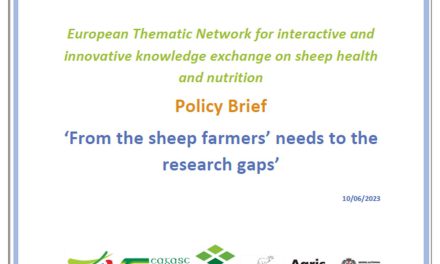This post is also available in:
![]()
![]()
![]()
![]()
What do we know about udder morphology
|
The Challenge |
Udder morphology is an important trait to consider for both dairy and meat sheep production systems. The characteristics of the udder and teats can affect milking ability (whether being milked by hand, by machine or by suckling lambs), disease incidence (such as mastitis) and production levels (both milk and meat).
|
Current Knowledge |
The morphology of a ewe’s udder has been well researched for dairy animals and in recent years interest has also grown in terms of those reared primarily for meat production. Depending on the type of system (dairy or meat) there may be differences in specific trait preferences. Reasonably full, spherically shaped and deep udders are often preferred as an indication of good milk production, but only to an intermediate level: udders that become too deep are harder to milk, harder for lambs to access and often more prone to injury. The attachment of the udder at the top and the floor to the abdomen should be wide and strong. Other examples include the placement and size of the teats. The preferred teat placement and angle, in dairy systems, allows easier access for mechanical milking, whilst still allowing lambs to suckle. In meat systems the main priority is to allow lambs to suckle, but other features such as protection from weather elements are sometimes often considered important as well. The size of the teat is also an important trait to consider because teats that are too big or too small may not fit the mechanical milking cup or influence how easily lambs attach to suckle.
Scoring systems: The evaluation of udder morphology can be performed by both direct measurements and the subjective assessment of various traits, relating to morphology, using linear scoring systems. A number of different scoring systems have been developed concentrating on both udder and teat related traits, which are simple to score and repeatable, such as: udder depth, udder furrow, udder attachment, teat placement, teat angle and teat shape to name just a few examples. In most dairy sheep breeding schemes the four characteristics of the udder that are considered most important are: udder depth (or height of the udder – recorded as the distance between the posterior insertion and the base of the udder), udder insertion (perimeter of the udder insertion to the abdominal wall), teat angle (angle of insertion of the teat with respect to the vertical) and teat length (from the insertion in the gland to its tip). Two examples of how to score the udder are shown in Figure 1.
Figure 1. Some example udder and teat linear morphology scores
Disease: The main disease associated with the udder of the ewe is mastitis. In addition to the presence of clinical mastitis, the level of somatic cell counts (SCC) in the milk are often used as an indication of udder health and milk quality. The recording of SCC has been introduced in a number of dairy sheep breeds throughout Europe. Research looking at correlations between SCC and udder type has shown that udders with good shape are less prone to subclinical mastitis. Although differences have been observed between different breeds, the size and placement of the teats, and the depth of the udder, can also predispose the ewe to developing mastitis. The presence of mastitis can then go on to affect the ewe herself, the quality and level of milk production and reduce the weight of lambs reared when compared to ewes without infection.
Genetics: A number of European dairy sheep breeds have now included udder morphology traits into their breeding programmes, with some meat breeds also starting to take interest. Traits included in scoring systems, such as the examples shown above in Figure 1, have been found to be moderately heritable. Selection for milk yield alone leads to a worsening of the udder morphology, therefore it is important to include udder morphology traits in dairy sheep breeding programmes to prevent this. Some udder traits have also been found to be phenotypically and genetically linked to milking ability and udder health, therefore improvements in udder morphology will also help to improve milking ability and reduce mastitis incidence in meat sheep.
|
The Impact |
The impact of unfavourable udder morphology can be substantial in both dairy and meat sheep systems. Problems associated with poor morphology and milking systems include slowing down parlour throughput, injury from changes in milking pressure or over milking, and infection. Similarly, if the morphology of the udder is poor in meat producing systems, lambs will not be able to suckle properly, thus affecting their growth rate and potentially injuring and introducing infection to the ewe. When the morphology of the udder is more favourable, ewes will be less prone to infection, remain in the flock longer, culling and replacement rates will be reduced, and production levels in terms of milk and meat will be improved.
|
Take home messages |
- Udder morphology is important to be aware of in both dairy and meat sheep producing systems.
- Udder morphology traits are heritable.
- Poor udder morphology may negatively affect milk production, lamb production and increase the chances of developing infections such as mastitis.
|
Contact: This briefing has been prepared by SheepNet researchers at SRUC and Neiker. For further information discuss with your local coordinator of the Scientific and Technical Working Group. |







